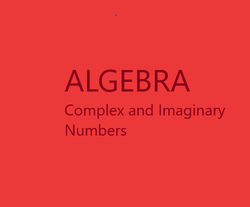If a square root of a negative number is taken, we quickly run into a problem. No real number when multiplied by itself gives a negative number. So, a new number called i is created and defined to be the square root of -1. If we square this number, i2, we get -1. When we cube i we get -i, and when we raise i to the fourth power we get 1. As powers of i increase we go through the cycle of these four values.
If we multiply i by a coefficient we get what is called an imaginary number.
The name is misleading, these are actual numbers, and are of great importance.
A number consisting of a real term and an imaginary term of the form a + bi is called a complex number.
Complex numbers can be graphed using two axes, the horizontal axis labeled x and the vertical axis labeled iy. So, think of complex numbers as two-dimensional numbers. It is as simple as that.
When we add, or subtract, complex numbers we add, or subtract, the real part and add, or subtract, the imaginary part.
3 + 4i is to be added to 5 + 2i. Adding 3 and 5 we get 8, and 4 plus 2 gives 6.
The sum above is 8 + 6i.
If we multiply the numbers (3 + 4i)(5 + 2i) we must treat the numbers as though they are binomials, and multiply as we would multiply binomials.
(3)(5) + (3)(2i) + (4i)(5) + (4i)(2i) = 15 + 6i + 20i + 8i2
Since i2 is -1, we get 15 + 6i + 20i – 8 = 7 + 26i
Definition: The conjugate of a complex number has the opposite sign for the imaginary term.
The numbers 4 – 2i and 4 + 2i are conjugates of each other.
It is desirable to not have i in a denominator. To fix the problem, multiply any complex number in the denominator by 1 in the form of its conjugate divided by itself.
As an example, start with the number below, and remove any imaginary number from its denominator.
(2 + 3i) ÷ (4 – 2i)
(2 + 3i) (4 + 2i) = 8 + 4i + 12i + 6i2 = 2 + 16i = 1 + 8i
(4 – 2i) (4 + 2i) 16 + 8i – 8i – 4i2 20 10
Notice the imaginary parts all disappear from the denominator. This will always happen.
Think about the factoring rule
Absolute Value of a Complex Number
Finally, what is the absolute value of a complex number? Well, the absolute value of a real number the distance from the point to the origin. The same thing is true for absolute values of complex numbers. Recall that complex numbers are two-dimensional, so we have an x distance and a y distance. Since the axes are at right angles, the absolute value of a complex number requires the Pythagorean Theorem.
Find │3 – 4i│.
(32 + (-4)2)1/2 = (9 + 16)1/2 = 251/2 = 5



















 The Linear Equation and Related Equations and Inequalitieson 08/15/2024
The Linear Equation and Related Equations and Inequalitieson 08/15/2024
 Understanding Calculus: A Simplified Approach to Derivativeson 08/05/2024
Understanding Calculus: A Simplified Approach to Derivativeson 08/05/2024
 Limits: Vital Building Blocks of Calculuson 08/01/2024
Limits: Vital Building Blocks of Calculuson 08/01/2024
 Mardi Gras Collectibleson 02/02/2023
Mardi Gras Collectibleson 02/02/2023




Comments
Use of calculators is here to help parents quickly check work, not as a resource for students. Math develops a logical way of thinking, not just finding solutions to problems, and overuse of calculators is not always a good idea. It gets the answer fastr, and when I write math for a publisher I use one to elimiante careless errors and speed things up to meet deadlines, but students need to be taught how to work things out, hence have the logic thought process involved.
blackspanielgallery, Thank you for the practical information and the product line.
Are complex and imaginary numbers taught through books and practice or books, calculator and practice? Some schools have kindergarten through second grade Monday through Friday and third through 12th grade just two days a week. Wouldn't teachers just about have to incorporate calculator instruction and use in such a virtual instruction-dependent situation?